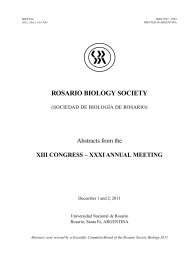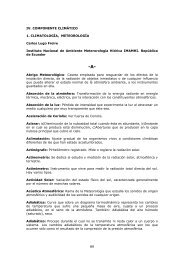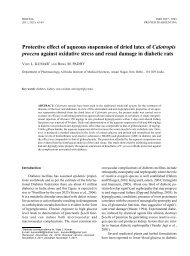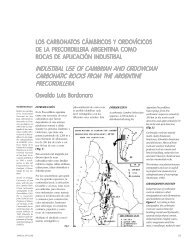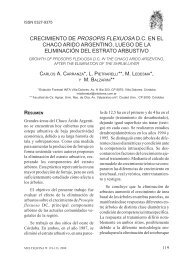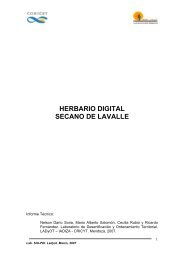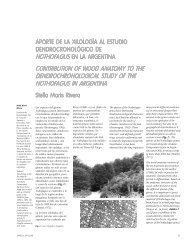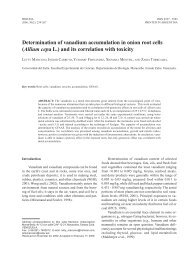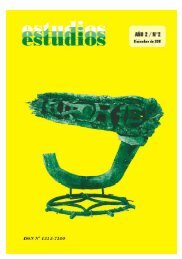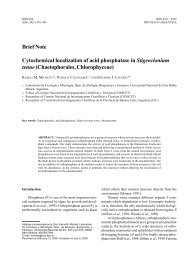XXII Annual Scientific Meeting, Tucuman Biology Society ...
XXII Annual Scientific Meeting, Tucuman Biology Society ...
XXII Annual Scientific Meeting, Tucuman Biology Society ...
You also want an ePaper? Increase the reach of your titles
YUMPU automatically turns print PDFs into web optimized ePapers that Google loves.
192 ABSTRACTS<br />
105.<br />
COMPARISON OF INTRAORAL RADIOGRAPH TECH-<br />
NIQUE FOR LOWER THIRD MOLARS SURGERY: PRE-<br />
LIMINARY STUDY<br />
Budeguer AN, Cajal JC, Morales Abújder EM, Aragón HN, Chelala<br />
de Chaya MS.<br />
Cátedra de Cirugía 1º curso Facultad de Odontología, UNT. Av.<br />
Benjamín Aráoz 800. E-mail: juceca1@yahoo.com.ar<br />
The objective of this work was evaluate through different radiograph<br />
techniques (retro alveolar bisectal, parallaje and parallelism)<br />
all the information about lower third molars’ root structure. Those<br />
techniques were performed to seven patients. Only one observer<br />
did the inform: total number of roots; number of mesials’ roots;<br />
curvature of mesials’ and distals’ roots; and disposition; between<br />
all the Rx techniques previously named. The results show that with<br />
the bisectal and the orthoradial technique, 71,4% of the lower third<br />
molars observed had two roots; when modifying the horizontal<br />
angulations of the central ray, 42,9% of the roots were fusioned<br />
and the 57,1% were separated. With the orthoradial technique, and<br />
the one varied from mesial and distal, 28,6% of the roots were<br />
fusioned and 71.4% were separated. For mesials roots, with bisectal<br />
and Orthoradial technique, 57,1% had only one root, and the 42,9%<br />
left had two roots, but when modifying the angulations from mesial<br />
and distal, 85,7% had one root, and 14,3% had two roots. Conclusion:<br />
A higher percentage of cases where roots are separated is<br />
observed when modifying the angulations of the central ray in<br />
parallaje technique and it also improves the visualization of mesial’s<br />
root curves, all very useful parameters to predict the kind of difficulties<br />
the surgeon could face during surgery.<br />
106.<br />
SOME ALOE GOODNESS<br />
Fernández de Aráoz DS.<br />
Facultad de Agronomía y Zootecnia. U.N.T. Av. Roca 1900.<br />
Tucumán. E-mail: deliciasfa@hotmail.com<br />
The Aloes had been used along the human history until our days in<br />
several sicknesses. The aim of this work is detach the aloe medicinal<br />
values and its popular uses, just as a first approximation to later<br />
chemistry and botany studies. A search on bibliography, the most<br />
common uses at folk belief was asked using semi structured interview<br />
at people, dermatology doctors about the way they prepare<br />
the aloe and the results obtained. The two principal products obtained<br />
from the Aloe are: the acíbar and the gel, which are very<br />
different between themselves, as chemical, pharmacology as therapeutic<br />
point of view. The most common Aloe preparations have a<br />
great medicinal value demonstrated by the tissue regeneration at<br />
dermal level results. People obtained excellent results in radiation<br />
cases, in skin dryness, allergies, insect’s bites or nettle. The application<br />
of fresh leaves mitigate the irritation. Eating pieces of fresh<br />
leaves, calm the digestive acidity, at internal uses of Aloe, it is very<br />
difficult demonstrate its efficiency, like in asthma, rheumatic pain,<br />
anemia, kidney infections, cancer, etc. It is very efficient in digestive<br />
disorders and ulcer gastric. The problem in chronic or internal<br />
disease is that the patient does not use only Aloe therapy, but several<br />
at once. This is a first approximation about the Aloe uses in<br />
popular medicine.<br />
BIOCELL 30(1), 2006<br />
107.<br />
ANTAGONISTIC ACTION OF RHODOTORULA GLUTINIS<br />
AGAINST PATHOGENIC FUNGI OF LEMON<br />
Maldonado MC, Balderrama Coca M, Navarro AR.<br />
Instituto de Biotecnología. Facultad de Bioquímica, Química y<br />
Farmacia. UNT. Ayacucho 465. (4000) Tucumán, Argentina. Email:<br />
biotec@fbqf.unt.edu.ar<br />
It was studied the antagonistic action between Rhodotorula glutinis,<br />
and pathogenic fungi of lemon: G. candidum, F. moniliforme, A.<br />
clavatus, P. expansum and P. digitatum. Were made solid assays to<br />
evaluate the existence of antagonistic action. A suspension of R.<br />
glutinis (1 x 10 8 UFC/ml) was dispersed all over the surface of<br />
Sabouraud plates, after 1 h at room temperature, was carry out in<br />
the center of the plate a hole, it was filled with 20 ul of phytopathogenic<br />
fungi (1 x 10 4 spores/ml). The plates were incubated during 5<br />
days at 28°C, after this time the percentage of inhibition of phytopathogenic<br />
growth was evaluated. In presence of R. glutinis was<br />
observed a total inhibition of G. candidum growth, (sour rot). There<br />
was also a total inhibition of F. moniliforme growth (saprophytic<br />
fungi of lemon), that produced a cotton-like material and gave bad<br />
aspect to fruits. The growth of A. clavatus, P. expansum and P.<br />
digitatum (green mold) was inhibited among 75-80%. Our next<br />
objective will be determinate the mechanism of action of this<br />
biocontrol agent.<br />
108.<br />
IN VIVO STUDY OF ANTIFUNGIC ACTION OF BACILLUS<br />
SPP. METABOLITES<br />
Maldonado MC, Gordillo MA, Navarro AR.<br />
Instituto de Biotecnología. Facultad de Bioquímica, Química y<br />
Farmacia. UNT. Ayacucho 465. (4000) Tucumán. E-mail:<br />
biotec@fbqf.unt.edu.ar<br />
It was studied antifungic action of Bacillus spp. metabolites (BM)<br />
by in vivo assays. Assay A: We worked with 3 lots of lemons. The<br />
first lot had farmy lemons (without any treatment), second lot had<br />
lemons treated with NaHCO 3 ,hot water and synthetic antifungic<br />
agentes (SAA). In third lot were lemons treated with NaHCO 3 , hot<br />
water and BM. Assay B: We worked with four lots of lemons. The<br />
first lot had lemons with NaHCO 3 , hot water, SAA and wax. The<br />
second lot had lemons with NaHCO 3 , hot water, SAA and wax.<br />
The third lot had farmy waxed lemons and in the last lot had lemons<br />
treated with BM and wax. All lemons were placed in boxes.<br />
All boxes were placed 3 weeks at 4°C and them one week at room<br />
temperature. The % disease was determinated at 7 – 30 days.<br />
In assay A the lemons treated with BM were infected 30% and the<br />
disease of farmy lemons were 100%. In assay B the lemons treated<br />
with BM were infected 20% while 90% disease of farmy lemons<br />
were observed. In both assays the % disease of lemons treated with<br />
SAA was 0-1%. It was demonstrated that wax have an protective<br />
effect, because the % disease saw in assay B was lower than the<br />
observed in assay A. These results are accord with the obtained,<br />
previously, in vitro assays.



